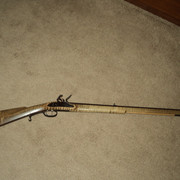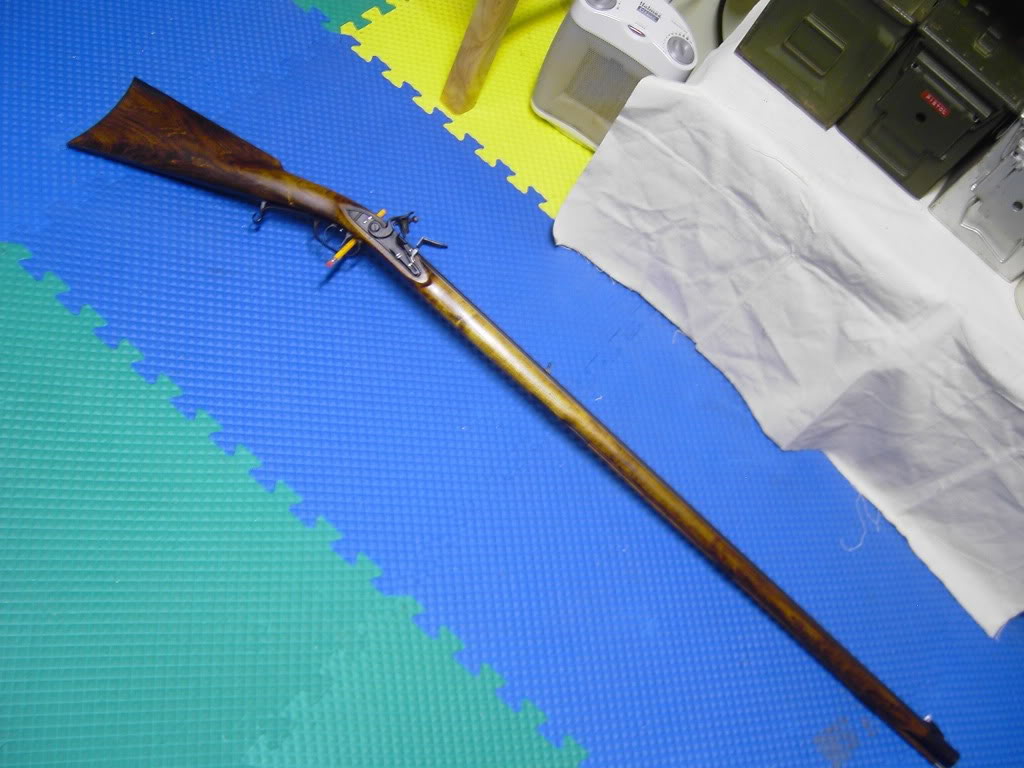If it's purely a squirrel and plink-around rifle, you honestly could go all the way down to .24 or .22. Most people don't go lower than .32, because even then, a metal ram rod isn't a bad idea, let alone anything smaller. I made the .22 I had with a barrel meant for an unmentionable (technically, it was a .218 bore, but when you force-load a naked piece of F-Buckshot in the muzzle, it forms to the grooves anyway), just worked it to the shape I wanted with a grinder and files. A .24 (technically made from a barrel for a .243 unmentionable) could use a naked no.4 Buckshot. You can get molds for that small from places like Marty's Arms, in MN., but you could also just buy 8 LBS jugs from Ballistic Products.
.22 ball of pure lead weighs around 16gr (the B.P. shot has antimony, so its a little lighter)(granted, I shot mine with resized cast bullets meant for reloading .22RF); but that's around 3,500 balls for $38.99 . A .24 Ball weighs 21gr (alloy would weigh a bit less), and that's 2,666 balls for the same price. I don't know about you, but that's about a lifetime's supply

. 5gr of 4F powder would make that ball crack pretty good, especially since that's what .22LR was originally loaded with, but with a 38-40gr bullet, standard velocity ammo was 850-900fps, and you'd get about 1,400 charges per pound, about 700-875 shots if you're wanting a flinter. Not a long range gun, but good enough for normal small game distances.
They're pretty cheap and quiet to shoot, but I recommend a brass or steel or stainless steel rammer.
The smallest you're going to see made by a large Mfg is .32 (#1.5 Buck), and there are only a couple companies that offer rifles in that. More common are .36's (00.5 Buck, with a thick patch), but not by much. In either case, they are almost always overbuilt, and you won't find one that weighs less than 5 LBS, which is overkill for a dedicated small game rifle, IMO. Traditions imports their percussion "Crockett" (around $500) rifle and I believe they used to offer their "Deer Hunter" model in .32 as well (similar price). Pedersoli offers their "frontier deluxe" ($780) model (flint and perc.) in .36; also, they have their "Kentucky Rifle) ($750) (F&P) in .32. Pedersoli also offers their "Pennsylvania" ($900) (F&P) in .32, and the "Scout" ($900) Rifle in .32.
I might have missed a few, but these are primarily what you are going to see, if you can find them in stock. As you can see, the prices are pretty high, easily equaling the low end of custom pieces (exception being the traditions rifles, but you probably already guessed that), while not really providing a custom fit (in size, weight, fit to you, suiting the purpose ect). High end kits like the Kibbler's can be exceptional quality, IF you make them so (the parts you are supplied with are well made, just not finished) ; however, they are still overbuilt for a dedicated small game rifle, in my opinion (not to mention, the kits run up into the low-mid range of custom pieces, AND you have to put it together).
Do not be timid on the rate of twist for dedicated small-game rifles, you're not going to really be using large charges and a projectile needs a minimum amount of RPM to be stable in flight. Balls require less, being a fairly stable shape to begin with, but too slow of a twist is often one of the biggest failings of the large Mfg's offerings; as it usually requires an unnecessarily large charge to shoot well. A .22 should probably be `around a 16", .24 and .25 around 20", .27 around 25", .32 around 28", and .36 at around 35".
My ideal squirrel rifle would be a .22, with a 28" barrel (tapering from .6" to .5") and 16" twist, loaded with either a piece of F buck or a 25gr cast slug for an air rifle, with the lock being the Small 3" Germanic Lock from The Rifle Shoppe (or one made like it), for sights- either 1 standing notch- with a couple folding leaves for target shooting (or a tube sight, or a normal aperture sight with elevation adjustment). My second choice would be a .32 set up the same way, only difference being the barrel either being .7" straight or .7"-.6" tapered. While I would want something similar in size to my Remington 512 rifle I grew up with (longish sight radius, slender gun, with good balance and light weight), you could go down to a 16" barrel for a carbine, if you wanted, but I would consider a rear-mounted aperture sight or tube sight to make up for the short sight radius. Could make it a double gun, if you wanted (I prefer O/U configuration)
Another option are smoothbores, and while 20-10 bore make good bird and clay guns, I feel they are overkill for a dedicated small-game gun. More appropriate, in my opinion, would be .40 and .45 guns. At the closer range most small-game is hunted at (or can be hunted at), you really don't need a lot of shot. Overly large payloads just means more shot to pick out of the squirrel, and higher costs (in powder and shot). 1/2 oz of shot is plenty for squirrel, and .40 and 45 bores utilize that well. While I am a rifleman, if my ideal small-game smoothbore would be .40, with a 28" barrel (tapering from .8"-.55") reamed and tapped for .410 chokes (yes, I "cheat", but they make the gun a little more versatile, IMO), with either the same Small 3" Germanic Lock or an L&R "Manton" lock, and a front blade with a fold-down notch rear sight (to make it a little easier to be both a good squirrel gun and clay/bird gun). You could make it a double gun, if you wanted.
My goal with either a single smoothbore or rifle would be a sub 4lbs gun, that is handy and can be carried around with you on walks easily (I think Sir Samuel Baker called them "walking rifles" or something to that effect), my weight goal would be 5ish lbs for a double gun.





